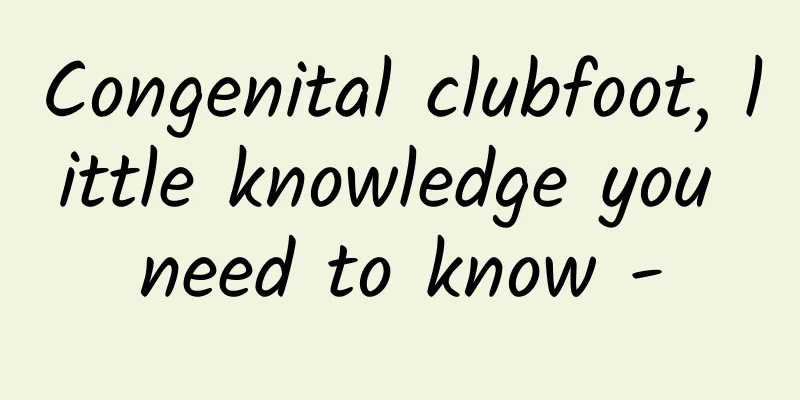Congenital clubfoot, little knowledge you need to know -

|
Patient: Doctor, can you see whether my baby has clubfoot? Doctor: Parents, please don't worry. Let's first clarify what clubfoot is. We generally call it congenital clubfoot, which is a general term for a group of complex deformities, including high arches, adduction, inversion and drooping of the "little feet" in their natural state, and the appearance is similar to a "horse hoof". The incidence of this deformity is about 0.9-7‰, more boys, with a male-to-female ratio of about 2:1, and about half of the children will have bilateral disease. High arches are usually caused by contracture of the plantar fascia and ligaments, and the hindfoot moves closer to the forefoot, resulting in a high arch. Adduction deformity is caused by the axial deviation of the talus, which causes the talonavicular joint to form an adduction deformity after inward deviation. At the same time, the longitudinal axis of the talus is parallel to the calcaneus, and the subtalar joint has adaptive changes, which looks like a varus deformity. Finally, the shortening of the calf muscles and the short Achilles tendon cause foot drop deformity. Patient: How did my baby get this disease? Doctor: This disease usually has no specific cause, it may be the combined effect of multiple factors. When the fetus is developing in the uterus, the position of the foot is not good, and the uterine wall squeezes it, resulting in equinovarus deformity. Abnormal development of the body's own nerves, muscles and bones can also lead to foot bone deformity and muscle imbalance, resulting in adaptive changes in joints and soft tissues. Patient: Will it affect my baby’s walking in the future? Doctor: Without intervention, as the child grows, the foot deformity will affect the weight-bearing capacity of the entire leg. The reduced weight-bearing capacity of the leg will affect the development of the leg muscles, causing the lower limbs to become thinner and shorter, and the feet to become smaller. Generally, the difference between the two legs is within 1 cm. The child's walking posture is abnormal, and the weight falls on the skin on the outside of the dorsum of the foot, which will cause calluses. Patient: Then we need to get treatment as soon as possible. My baby is three months old. Is it too late? Does he need surgery? Doctor: The treatment effect is good within 1 year old, especially the intervention within 6 months, which will basically not affect the child's future walking. The current internationally common treatment method is the Ponseti method. After more than 40 years of clinical practice, the method is mature and reliable. Through multiple plaster corrections and braces, some children with plantar flexion deformity only need minor surgery to lengthen the Achilles tendon, and the treatment success rate is over 90%. During treatment, professional manual correction and plaster fixation are first used to gradually correct the high arch, adduction, and varus deformities, and the plantar flexion will also be gradually improved. Generally, the plaster is changed once a week, and after 4 to 5 consecutive adjustments, the brace can be worn. This brace can be adjusted according to your baby's condition. The horizontal bar should be shoulder-width apart, and the affected foot should be abducted 60° to 70°, and the healthy foot should be abducted 30° to 40°. The brace should be worn for at least 23 hours a day for the first three months, and can be removed briefly for personal cleaning. Later, the brace can be worn when the baby is asleep, ensuring 14 to 16 hours of wearing time per day. To prevent recurrence, we usually recommend wearing it until about 4 years old. In addition to the above treatments, you also need to bring your baby to the rehabilitation department for rehabilitation training, and conduct comprehensive training on the muscle strength, balance ability, and gait of the lower limbs to help the baby recover faster. Patient: I understand. Thank you, doctor! Doctor: To sum up, the deformity characteristics of clubfoot include high arch, adduction, inversion, and plantar flexion. Through reduction, about 5 times of plaster fixation, and wearing of braces for about 3 years, plus persistent rehabilitation training, the "little feet" will be gradually corrected and restored to normal. |
<<: 【Love Ear】Healthy ears·Scientific ear protection
Recommend
Can pregnant women eat almonds?
It is very important for pregnant women to pay at...
What is the main function of a fresh-keeping bag? Can a fresh-keeping bag like a shower cap be used?
Fresh-keeping bags are widely used in daily life ...
What is the material of the decoration material Hexiang board? Does Hexiang board contain benzene?
In recent years, a kind of Hexiang board is often...
A woman dreamed that her sister died
Many people should have this kind of energy. When...
Levonorgestrel capsules for pregnancy
The main ingredient of levonorgestrel capsule is ...
What should I eat after having an abortion?
Abortion is the best choice for many women who do...
I had sex the next day after the polyp surgery.
Cervical polyps may directly affect women's n...
What to do if a girl's vagina is loose? Here are 4 ways to help you
The vaginas of many women will gradually become l...
How to regulate the lack of basic follicles
Few basal follicles is a relatively abnormal situ...
When is labia majora surgery necessary?
Women all love beauty very much, not only their e...
When will morning sickness get better? How to relieve it?
Pregnant women will go through a very painful pro...
How much does artificial insemination cost?
What is artificial insemination? Artificial insem...
How can women prevent Alzheimer's disease?
Alzheimer's disease is a common disease cause...
I still have lochia after a full month of cesarean section
After giving birth, some residual substances will...









